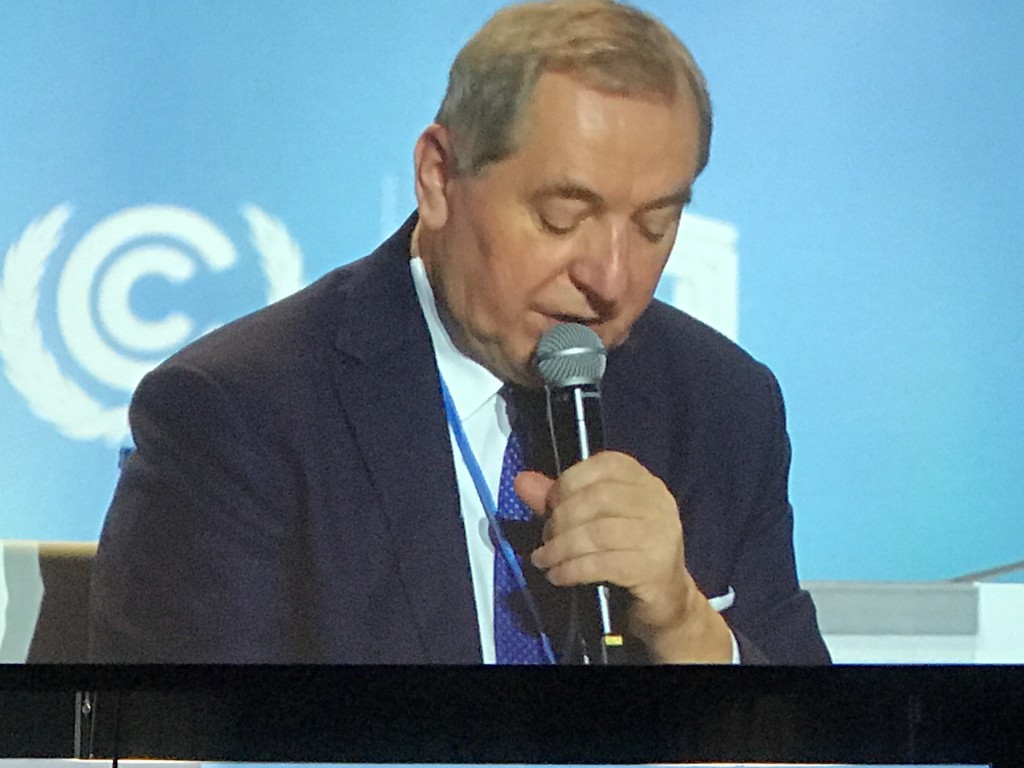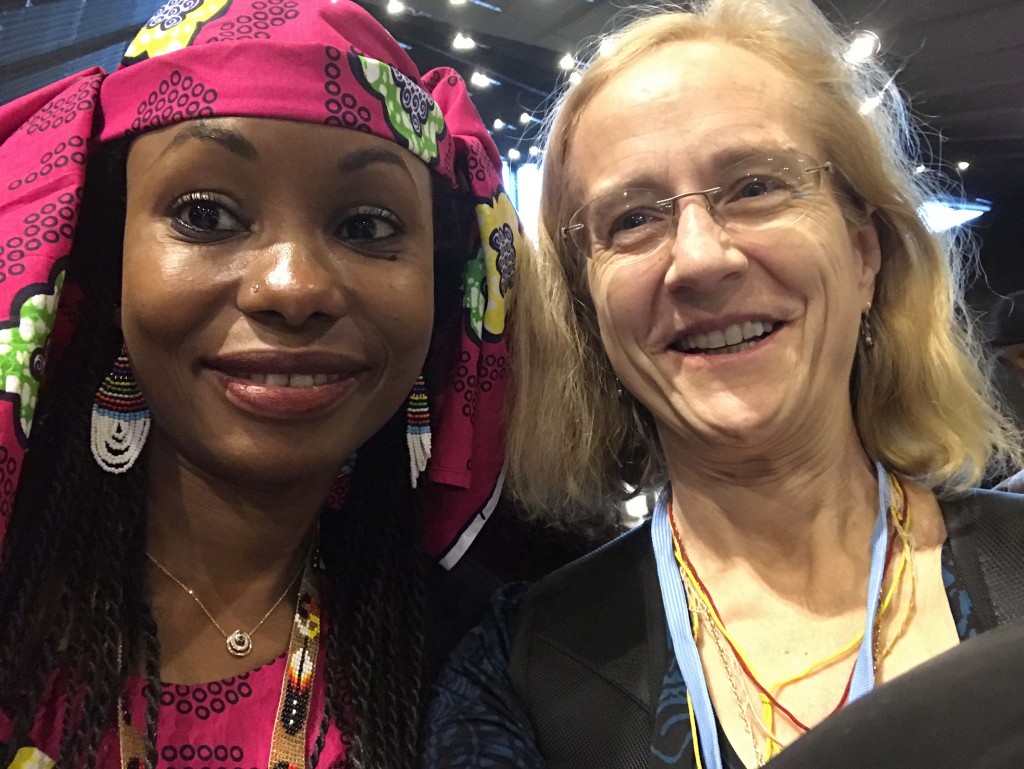At Paris, the Parties agreed to engage in a Facilitated Dialogue, concluding this year in Katowice. Many observers saw that facilitated dialogue as a dry-run for a global stocktake, since the first full global stocktake will only happen in 2023. Last year, in Bonn, the Fiji Presidency of the COP put a Fijian stamp on this facilitated dialogue, drawing on the Fijian tradition of storytelling, and launched the Talanoa Dialogue. Over the past year, everyone has been invited to take part in the Talanoa Dialogue, either by participating in a facilitated dialogue or by submitting a document to the UNFCCC. Cornell University made a submission, as did Cambridge University. Swarthmore, let’s sharpen our pencils!
Tuesday is the day for Ministerial Talanoa Roundtables. These were prefaced by an example of storytelling in the high-level session, immediately after the summary of the pre-2020 ambition global stocktake.
The COP President introduced the process, and the High-Level Champion Inia B. Seriuratus summarized some of what the Talanoa Dialogue has produced, most notably a 2018 Yearbook and Summary for Policy-Makers demonstrating the breadth of commitments by nonparty stakeholders: cities, regions, investors, civil society (including, I believe, 9000 cities, 2400 regions, 6000 businesses).
Then the participants in the model dialogue came to sit together at the front of the stage. Seriuratus facilitated.
Hindou Oumarou Ibrahim was the first one invited to tell her story. Here’s a rough transcription:
“Climate change is a big crisis. Indigenous communities resolve by sitting down and sharing stories on reality. Women do this. I will only talk about the third question: how we get there. Indigenous people, we create the pathway of how we get there. We live in harmony and protect the environment because this environment is protecting us.
“A man who has hundred of cattle go for grazing: he make sure they have access to water and pasture. He doesn’t call the cattle a of home, b of home. They all have names. He looks at print in soil. We put our print in the soil to know who is whom. We [don’t] just sit in the back and we know if each one is home or one is missing.
“We do that because we have to take care of each of them. We don’t just count 100. Each solution matters. Each one matters.
“We have this window of action, this action taken by Indigenous People. We have to implement it right now; we have to do it all together. Finance matters, action matters. Time is not in our behalf.
“As Indigenous People what we teach in this history is how we live all together, how we get action where it is not happening. We cannot choose what we will do–we cannot choose energy and leave transport because another country is doing it.
“Indigenous People are 370 millions, 4 percent of the population, but we are protection for more than 80 % of world biodiversity. How we get where we are going.”
The Polish minister Henrik spoke second.
“History is very interesting and my age also allows me to reminisce more than 20-30 years, back to the 1970s when Poland as country depending on Soviet Empire developed a very extensive industry and mining. At that point in Silesia many mines opened and hundreds of thousands of people worked in mining and heavy industry. Emissions from coal were over 470 million tons—a huge volume compared to modern times.
“Surely all of us know the story of solidarity, the transformation of 1990s. (Does everyone still know this story? Do Swarthmore students know the story?)
“We were coming out of a period when all cars filled the roads, we paid no attention to air pollution. In the 1970s when houses were built, no one paid attention to heat permeability or costs of heating because we had a lot of coal availability.
“After the 1990s, we started closing down the burden of heavy industry–not far enough, but climate and air protection in Poland was gaining attention and having some effects. Now we are concentrated on transportation, electromobility: at least hybrid cars, the number of cars is growing—effort has to be vast—city centers suffer the most from the pollution. We created an electromobility fund—introducing public transport program—changing busses from diesel to electric.
“We also have huge emissions from single-family houses. Our energy is based on coal but our share of coal is diminishing; we still have fumes, but we are using the best technologies, reducing sulfur by 30%, NOX by 50%. We still have CO2 emissions. There is still the challenge of heating single-family homes—and today is the first snow of winter–in order to try to rise to challenge, implementing large scale (25 billion euro) modernization of 1970s houses. We will replace windows and structural elements to produce a 50% reduction in heating, with a reduction of 18-20 million tons of carbon emissions per year. This includes replacement of old boilers and stoves with clean gas-based heating. We want our residents to benefit, to pay smaller bills for heating live in friendlier houses. Changes to climate policy should be accepted and supported by residents.
“We have crossed a long path from the last century to today’s challenges.”
Ms. Radna [?] of Iceland (sorry, no photo!)
“A century back, Iceland was a country of the north, with long and dark winters. We had to do something to improve living standards. We had two energy transitions: 1) electrify with hydro and geothermal, and 2) geothermal. Geothermal has been the most significant factor in improving life in Iceland.
“How were we building renewables on a large scale last century? We started small—individuals, farmers, entrepreneurs. A farmer could build a small hydro system using river running through his land. He could utilize geothermal—he looked at a hot spring and wondered, “Can I use it to heat my house?”
“To improve more significantly, we had to scale up. Hydropower stations and geothermal were assisted by state. Mid-century, the state went in as big actor, mitigating risk (sharing with municipalities): it supported research, funded the national power company to build hydropower system and grid.
“Of course, there were challenges along the way as we developed geothermal. It took resilience and stubbornness. When trying new things, they don’t go as predicted in first round. The state had to rely on foreign loans; the state had to provide capital to build the system. It created a long-term contract with power-intensive industries which now use 80% of our electricity. Iceland is not first place aluminum smelting companies thought of sending their business…but now…
“So we have been building power stations in beautiful places. Iceland is a beautiful nation—should we utilize everything or conserve some? This is a big issue for the public.
“What challenges are waiting? Transport and fisheries still rely on fossil fuels: this will be a challenge for us. Iceland has promised to be carbon neutral by 2040: the state is engaging stakeholders and businesses in dialogue.
“There are no magic tricks. If something doesn’t work, you have to try something else. Individuals have to understand us, business and policy-makers have to understand each other.
“One thing about inclusiveness and getting people to understand: you have to have gender equality—women participating on all levels.
“It is not impossible to decarbonize and improve the economy at the same time.”
Prime Minister of Fiji
“Last night I returned from the Middle East. I was in Lebanon, then Syria, then Golan Heights in Israel. I also met up with two prime ministers, in Lebanon and Israel. Everyone knows about the issues in the Middle East. Does everyone know about the Pacific?
“We are all in one canoe. We must participate in sailing that canoe into safe harbor for our children, our grandchildren, our great-grandchildren. We need the political vision that will help take us in this canoe to this safe harbor. If you think you are safe, not vulnerable—you will be vulnerable if we don’t follow what the scientists have told us—and I commend the scientists for the report.
“Where are we? In Poland, the first snow. On the other side of the world, it’s nice and warm—our children would want to come and play in snow, but then they would want to go back.
“We need funds: billions of dollars to provide for adaptation. And we need to commit ourselves to look at our NDCs–more ambition so we can reduce emissions as we promised ourselves by 2050 to zero.
“Let me tell you something about what’s happening in the Pacific: Tonga, Samoa, Fiji, Vanuatu get hit by cyclones about every 6 months. Winston was a category 5 cyclone. We didn’t know how strong it would be. We have never seen devastation like that caused by Winston: not only infrastructure but also agriculture—no more foodstuffs. Now villagers are worried about the next cyclone. Villagers demand seawalls and hurricane shelters, not just on the coast, also those on rivers.
“Many cannot associate climate change and the problems it brings in problems of agriculture and infrastructure: 44 dead; 33% GDP lost, hundreds of schools and of course homes. We are building back better.”
I will give the last word to Hindou, who was kind enough to take a selfie with me after the talk, and who responded to a question from Seriuratus about the role of women.
“Women can get us there. We are half of the world populations.
“If you take decisions without them, it’s a problem. Not just two women and three men at a table—gender balance there. No! You need to listen to what they are saying.
“I am talking about those who wake first, sleep last, and take care of communities. I am talking about teachers and healers. I am talking about my grandmother who never had a smartphone, who never saw the color of electricity, who never saw clean water from a tap, who continues drinking from river, this grandmother has lots of innovations because she makes predictions. She makes predictions about the next six months weather based on the trees, the birds’ displacement. When cattle lie down, they face south, rainy season is coming. This knowledge of these women–these women who lead us exactly where we need to go.
“Everyone deserves the same level of recognition.”




